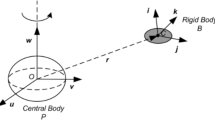Abstract
This paper studies the dynamics and stability of a rigid spacecraft subjected to gravity gradient torques exerted by the Sun and the Earth in the circular restricted three-body problem. We focus on the dynamics in a close vicinity to the Lagrangian collinear equilibrium points, and show that the linear stability domain predicted by the Beletskii-DeBra-Delp method in the two-body problem is modified due to the presence of an additional gravitating primary. The nonlinear differential equations are derived using a Hamiltonian formalism and are subsequently investigated using Poincaré maps. The effect of the gravity gradient torque is accentuated using difference Poincaré maps. The Melnikov integral method is utilized for studying the chaotic behavior of the gravity-gradient-perturbed system.
Similar content being viewed by others
References
FARQUHAR, R.W. “The Control and Use of Libration-Point Satellites,” Technical Report SUDAAR-350, Stanford University, July, 1968.
FARQUHAR, R.W. “The Utilization of Halo Orbits in Advanced Lunar Operations,” Technical Report TN D-6365, NASA, July, 1970.
HÉNON, M. “Vertical Stability of Periodic Orbits in the Restricted Problem,” Astronomy and Astrophysics, Vol. 28, 1973, pp. 415–426.
RICHARDSON, D. L. “Analytical Construction of Periodic Orbits about the Collinear Points,” Celestial Mechanics, Vol. 22, 1980, pp. 241–253.
GOMEZ, G. A., MASDEMONT, J., and SIMO, C. “Lissajous Orbits around Halo Orbits,” Advances in the Astronautical Science, Vol. 95, 1997, pp. 117–134.
HOWELL, K. C. and BARDEN, B. T. “Fundamental Motions near Collinear Libration Points and Their Transitions,” The Journal of the Astronautical Sciences, Vol. 46, No. 4, 1998, pp. 361–378.
PAPADAKIS, K. E. “The 3D Restricted Three-Body Problem under Angular Velocity Variation,” Astronomy and Astrophysics, Vol. 425, 2004, pp. 1133–1142.
PERDIOS, E. A. and RAGOS, O. “Asymptotic and Periodic Motion around Collinear Equilibria in Chermnykh’s Problem,” Astronomy and Astrophysics, Vol. 414, 2004, pp. 361–371.
GURFIL, P., ELIPE, A., TANGREN, W., and EFROIMSKY, M. “The Serret-Andoyer Formalism in Rigid-Body Dynamics: I. Symmetries and Perturbations,” Regular and Chaotic Dynamics, Vol. 12, No. 4, July 2007, pp. 389–425.
COCHRAN, J. E. “Effects of Gravity Gradient Torque on the Rotational Motion of a Triaxial Satellite in a Precessing Elliptic Orbit,” Celestial Mechanics, Vol. 6, 1972, pp. 127–150.
KINOSHITA, H. “First-Order Perturbations of the Two Finite-Body Problem,” Journal of the Astronautical Society of Japan, Vol. 24, 1972, pp. 423–457.
ABAD, A., ARRIBAS, M., and ELIPE, A. “On the Attitude of a Spacecraft Near a Lagrangian Point,” Journal of the Astronomical Institute of Czechoslovakia,Vol. 40, No. 5, 1989, pp. 302–307.
BALAN, R. “Horseshoe and Nonintegrability in the Restricted Case of a Rigid Body in a Central Gravitational Field,” Technical Report, Princeton University, June, 1995.
ELIPE, A. “On the Attitude Dynamics of Perturbed Triaxial Rigid Bodies,” Celestial Mechanics and Dynamical Astronomy, Vol. 81, No. 1–2, 2001, pp. 3–12.
BELETSKII, V.V. “Motion of an Artificial Satellite about its Center of Mass,” Artificial Satellites of Earth, 1959, pp. 13–31.
DeBRA, D. B. and DELP, R.H. “Rigid Body Attitude Stability and Natural Frequencies in a Circular Orbit,” The Journal of the Astronautical Sciences, Vol. 8, No. 1, 1961, pp. 14–17.
BROUCKE, R.A. “On the Use of Poincaré Surfaces of Section in Rigid-Body Motion,” The Journal of the Astronautical Sciences, Vol. 41, 1993, pp. 593–601.
BARKIN, Y.V. “Motion of a Spacecraft about Its Center of Mass at a Libration Point of The Earth-Moon System,” Cosmic Research, Vol. 18, 1980.
KANE, T. R. and MARSH, E. L. “Attitude Stability of a Symmetric Satellite at the Equilibrium Points in the Restricted Three-Body Problem,” Celestial Mechanics, Vol. 4, 1971, pp. 78–90.
BLOCH, A. M., GURFIL, P., and LUM, K.-Y. “The Serret-Andoyer Formalism in Rigid-Body Dynamics: II. Geometry, Stabilization and Control,” Regular and Chaotic Dynamics, to appear.
MARSDEN, J. E. and RATIU, T. S. Introduction to Mechanics and Symmetry, Springer, 2004.
KAPLAN, M.H. Modern Spacecraft Dynamics and Control, Wiley, 1976.
KANE, T. R. Spacecraft Dynamics, Mcgraw-Hill, 1981.
SANDOR, Z., ERDI, B., and FUNK, B. “The Relative Lyapunov Indicators: An Efficient Method of Chaos Detection,” Celestial Mechanical and Dynamical Astronomy, Vol. 90, 2004, pp. 127–138.
SANDOR, Z., BELLA, R., and TEGER, F. “Short Time Lyapunov Indicators in The Restricted Three-Body Problem,” Celestial Mechanical and Dynamical Astronimy, Vol. 79, 2001, pp. 29–40.
BIRKHOFF, G.D. Dynamical Systems, Vol. RI, A.M.S. Colloquium Publications, Providence, RI, 1927.
SMALE, S. Diffeomorphisms with Many Periodic Points, Differential and Combinatorial Topology, Princeton University Press, Princeton, NJ, 1963.
GUCKENHEIMER, J. and HOLMES, P. Nonlinear Oscillations, Dynamical Systems, and Bifurcations of Vector Fields, Springer Applied Mathematical Sciences Series, 1983.
WIGGINS, S. Global Bifurcations and Chaos: Analytical Methods, Springer Applied Mathematical Sciences Series, 1988.
MELNIKOV, V. K. “On the Stability of the Center for Time Periodic Perturbations,” Transactions of the Moscow Mathematical Sciences Institute, Vol. 12. MR 156048—Zbl 0135.3100, 1963, pp. 3–52.
MOON, F. C. and HOLMES, W. T. “Double Poincare Sections of a Quasi-Periodically Forced, Chaotic Attractor,” Physics Letters A, Vol. 111, 1985, pp. 157–160.
WIGGINS, S. “Chaos in the Quasiperiodically Forced Duffing Oscillator,” Physics Letters A, Vol. 124, 1987, pp. 138–142.
IDE, K. and WIGGINS, S. “The Bifurcation to Homoclinic Tori in the Quasiperiodically Forced Duffing Oscillator,” Physica D, Vol. 34, 1989, pp. 169–182.
SAHA, L. M., KHAN, A., and SARMA, T. P. “Effects of the Solar Radiation Pressure and Tidal Forces on the Rotational Motion of a Satellite,” Bulletin of the Astronomical Society of India, Vol. 28, 2000, pp. 147.
STEINDL, A. and TROGER, H. Chaotic Motion in Mechanical and Engineering Systems, Springer-Verlag, 1991.
Author information
Authors and Affiliations
Rights and permissions
About this article
Cite this article
Brucker, E., Gurfil, P. Analysis of gravity-gradient-perturbed rotational dynamics at the collinear lagrange points. J of Astronaut Sci 55, 271–291 (2007). https://doi.org/10.1007/BF03256525
Published:
Issue Date:
DOI: https://doi.org/10.1007/BF03256525




